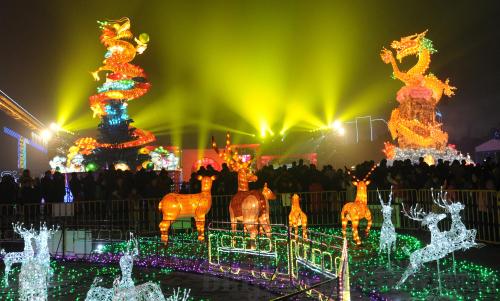|
 |
|
LANTERN FAIR: Tourists in Suzhou, east China's Jiangsu Province, enjoy two 14-meter-high dragon lanterns from Taiwan (WANG JIANZHONG) |
China's manufacturing sector continued to expand in January, but at a slower pace, which suggests a steady growth trend in the country's economy. Business activity in China's non-manufacturing sector also continued to expand in January, as the Spring Festival drove up retail sales.
Purchasing managers' index (PMI) for China's manufacturing sector fell to 50.4 percent in January from 50.6 percent in December 2012, said the National Bureau of Statistics and the China Federation of Logistics and Purchasing (CFLP) on February 1.
January marked the fourth consecutive month that the PMI remained above 50 percent, according to the CFLP. A reading above 50 percent indicates expansion, while a reading below 50 percent indicates contraction.
However, the indicator also dropped for the first time since August 2012 when it hit a nine-month low of 49.2 percent.
The slight retreat suggests that China's economy will exhibit steady growth in the near future, said Zhang Liqun, an analyst from the Development Research Center of the State Council.
Although manufacturers are continuing to expand, lower sub-indices for export orders and overstocked products point only to stable production activity instead of robust growth, Zhang said.
The PMI for the non-manufacturing sector came in at 56.2 percent in January, up 0.1 percentage points from December 2012, said the CFLP. This marked the fourth straight month of rises.
Value-added tax (VAT) reform in some pilot regions will be expanded to more areas as burdens on Chinese business have been reduced, said the Ministry of Finance on February 1.
As of February 1, the reform, replacing the turnover tax with VAT in transport and some service sectors, has reduced taxes by over 40 billion yuan ($6.4 billion) for more than 1 million taxpayers in 12 pilot regions, said the ministry.
It added that the reform had reduced burdens on lower taxpayers by an average of 40 percent.
Turnover tax refers to a levy on the gross revenue of a business. VAT refers to a tax levied on the difference between a commodity's price before taxes and its cost of production.
China introduced the reform in Shanghai last year to avoid double taxation. The program was later expanded to another 11 regions, including Beijing, Tianjin and Shenzhen.
China's capital and financial account remained at a deficit in the fourth quarter of 2012, dragged down by lackluster foreign investment amid a faltering global economic recovery.
The capital and financial account shrank to $31.8 billion from $51.7 billion in the third quarter, said the State Administration of Foreign Exchange.
Meanwhile, the country's current account surplus slid to $65.8 billion in the October-December period, down from $70.8 billion in the previous quarter.
In 2012, China saw a $117.3-billion deficit in the capital and financial account and a $213.8-billion surplus in the current account.
| 